- This yatra to Om Parvat and Adi Kailash was not just a journey through the Himalayas-it was a journey inward, into stillness and surrender. Get first-hand experience of yatra.
Our
Group did the Kailash Mansrovar Yatra in 2019. You can read about our Divine Experience
Here
This yatra was from October 3 to 11, 2025.
This yatra to Om Parvat and Adi Kailash was not just a journey through the Himalayas — it was a journey inward, into stillness and surrender. Every challenge felt like a quiet test of faith, every darshan a reminder of grace. For those who feel the call, the path will always open.
Introduction
Some
journeys are planned whilst others simply happen.
When our small travel group began dreaming of the Adi Kailash Yatra earlier this year, little did we know that we were responding to such a call — one that echoed softly from the mountains themselves.
This was not my first tryst with Kailash. Having undertaken two yatras before to Mount Kailash, I knew that no two pilgrimages are ever the same. Each time, the outer landscape mirrors an inner unfolding. This journey — from Kainchi Dham to the snow-laden Adi Kailash — was no exception.
It
was a tapestry of devotion, laughter, discomfort, grace, and above all,
surrender.
The Call of the Mountains
“Somewhere between the earth and sky, the Himalayas whisper truths that words can never hold.”
The idea of the Adi Kailash Yatra took shape soon after our group returned from a wonderful Kumbh Mela at Prayagraj. When the name “Adi Kailash” was mentioned, my heart stirred instantly. Mahadev’s call felt unmistakable.
Our little band of travellers had already shared many journeys together — seekers from different cities and spiritual traditions, yet united by one name: Shiva.
There
was a rare sense of comfort and purpose among us, the kind that only shared
devotion brings. It is what a friend calls Group Energy.
When Plans Find Their People
Over a long, laughter-filled lunch at Shireen’s house in May, the plan began to take form. While most preferred early October, I hesitated — a dear German friend, Irina, was visiting after several years. But the universe had its own plans. Irina joyfully decided to join us, and when we found ourselves one short of twelve, my friend Supriya instantly agreed to come along.
With Sudhir, Sucharita, and Manjushree deftly handling the logistics, we were ready by early October. We had engaged the services of Temple Tours for transport and lodging boarding. On the third of October we flew into Pantnagar, where three Innovas awaited — sturdy chariots for what lay ahead.
Kainchi Dham – The Blessing Begins
“Every yatra begins long before the first step is taken — in the heart’s quiet preparation.”
Our first destination was Kainchi Dham. On the way, we stopped at The Mud House Café — a cozy place overlooking the Himalayas. A simple chai break soon turned into a long, joyful meal as we soaked in the view.
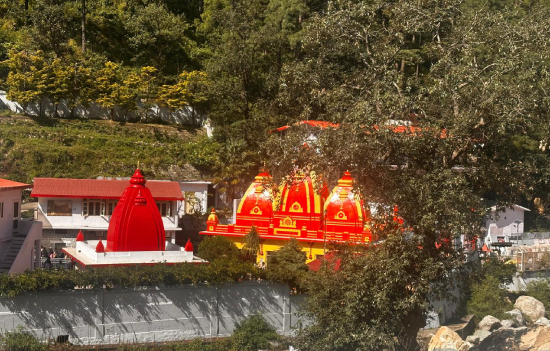
Later that evening, we reached Shri Neem Karoli Baba’s ashram — a long-cherished wish of mine. Though we missed the aarti, we had darshan and prasad, and promised to return at dawn.
The next morning began with our group’s ritual: an exuberant dance to the Shiv Tandav Stotram followed by a serene meditation led by Shireen. It was pure joy — movement, surrender, silence.
At the temple, I carried handmade chocolates as prasad. When I passed them to Shireen to offer at Baba’s shrine, the priest looked both puzzled and amused- perhaps his first chocolate offering! Love, I believe, is prasad enough.
Later,
at Kakrighat Hanuman temple, we meditated under ancient banyan trees beside the
flowing river. The peace was tangible-like being gently held by something vast
and invisible.
Kasar Devi – Magnetism of the Divine
“Some places do not ask you to believe. They simply make you believe.”
By noon, we reached Mohan’s Resort near Kasar Devi, gazing out over endless mountain ranges. The pull of these heights is impossible to describe — the heart wants to linger forever.
Kasar Devi, one of the Shaktipeeths, sits on a rare geomagnetic field anomaly — a natural vortex of energy, akin to Machu Picchu or Stonehenge. Science aside, what one feels there is unmistakable tranquillity.
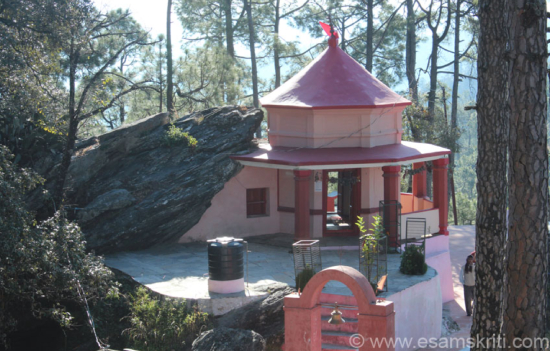
A hundred steps led to Devi’s beautiful shrine; another fifty to an ancient Shiva temple above. As the sun sank behind the peaks, the valley turned gold. It was too beautiful to leave-some of us returned the next morning, unable to stay away.
Meditation in the Cave of Vivekananda
While a few walked down Hippie Hill, some of us climbed back up in search of Sucharita — and stumbled upon a narrow cave said to be where Swami Vivekananda meditated. The crevice barely held two people, but Shobha and I slipped in and sat silently for half an hour.
The
stillness was profound. The air was thick with presence. When I emerged, my
eyes brimmed with tears I could not explain.
Jageshwar – Whispers of the Ancient World
“In silence, even stone speaks.”
On the way to Jageshwar, we stopped at Chitai Golu temple — its trees hung heavy with bells and handwritten petitions from devotees. I bought a small brass bell for my Ganesha at home.

The nearby Lakhudiyar Caves, with their prehistoric paintings of humans and animals, carried echoes from millennia past. Standing there, I felt the quiet continuity of devotion — from early man to us, all reaching toward something greater.
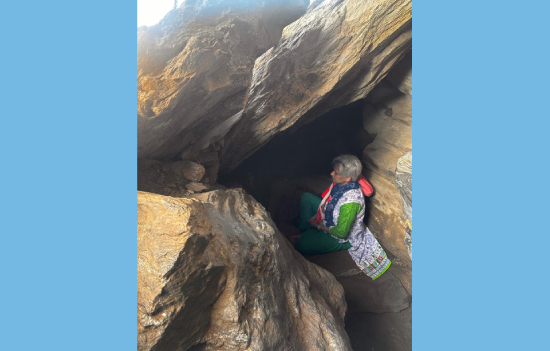
Jageshwar itself was breath-taking — a valley of deodars cradling 124 temples, some over 2,500 years old. That evening’s aarti shimmered with devotion.

The next morning’s Rudra Abhishek was deeply moving. We performed puja in small groups before visiting the main shrines — Jageshwar, Mrityunjaya, Kedareshwar, Batuk Bhairav. The air felt alive. At the Jataganga stream below, we built small cairns of stones — humble symbols of surrender.

A
Himachali cap caught my eye that day. It stayed on my head all the way to
Pithoragarh.
A Pause at the Heartfulness Ashram
We reached Pithoragarh’s Pine Resort by evening. Supriya and I, both long time Heartfulness practitioners, visited the local ashram with Shireen, Shoba and Dilip. The simplicity and warmth of the meditation there felt like a gentle grounding before the adventure ahead.
The Real Yatra Begins
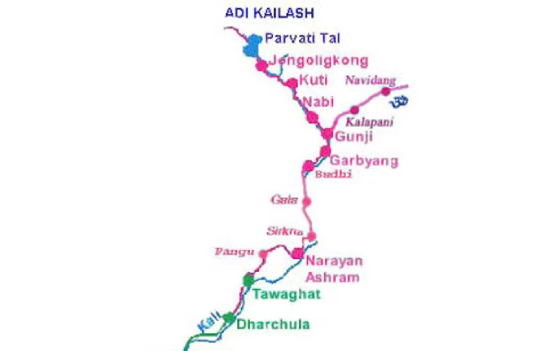 Route.
Route.
“Every pilgrimage tests your body, only to reveal the strength of your spirit."
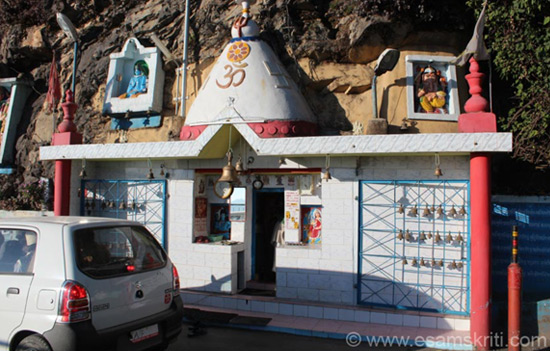 Gurna Devi Mandir, ahead of Pithoragarh, is where all stop and take Mata blessings.
Gurna Devi Mandir, ahead of Pithoragarh, is where all stop and take Mata blessings.
The next morning began with blessings at Gurna Mata Mandir — a ritual of protection before entering rougher terrain. The road to Dharchula was arduous. We had to change vehicles and had three Sumos waiting for us. By the time we arrived, I was battling a stubborn stomach ailment.
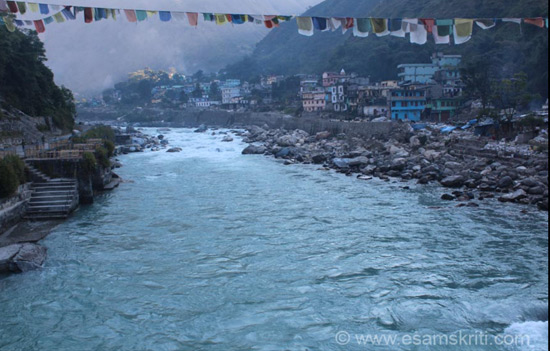 U see River Kali at Dharchula.
U see River Kali at Dharchula.
Foreigners
are not permitted beyond that point, so Irina stayed back at Narayan Ashram
while we continued with our guide Vinod and a fearless driver. The road all but
disappeared at times, with the Kali river flowing below separating India and
Nepal and landslides ahead.
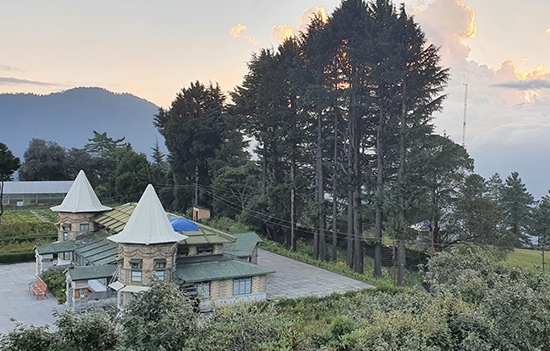 Narayan Ashram overview. Pic by Snehal S.
Narayan Ashram overview. Pic by Snehal S.
That night at Nepalchu Homestay, freezing and unwell, I clung to faith — and Supriya’s stock of Lomotil!
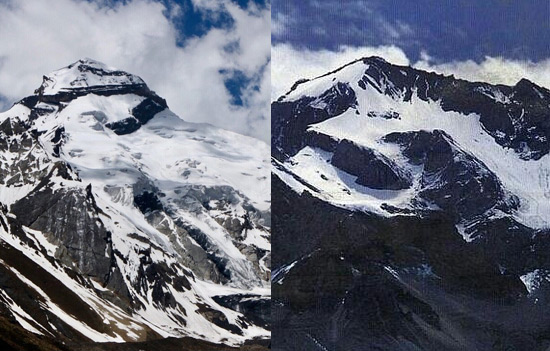 Adi Kailash and Om Parvat. Pranam.
Adi Kailash and Om Parvat. Pranam.
Om Parvat – The Sacred Symbol Reveals Itself
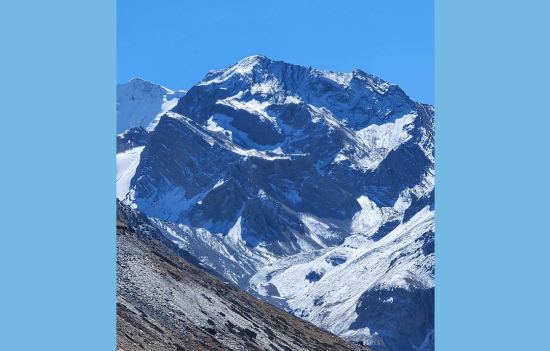
The next morning dawned grey and uncertain. The army had reportedly closed the route, but we decided to try anyway. After offering prayers at Manokamaneshwar Mahadev temple where I literally pleaded into Nandi’s ear for a darshan, we headed toward Kali Temple on the way to Om Parvat.
This
temple is dedicated to Ma whilst another to Shri Hanumanji. The priest showed
us the origin of the river Kalinadi. He asked us to wait for a couple of hours
before proceeding to Om Parvat. I found the atmosphere very serene and while
the others decided to visit the canteen and a shop run by the Maratha regiment,
Sanjeev and I stayed back to meditate.
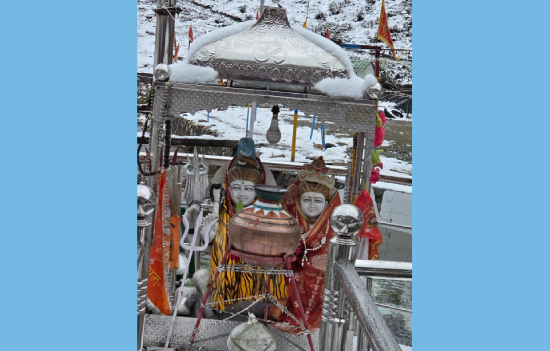 Just outside Ma Kali Temple where we saw origin of Kali river.
Just outside Ma Kali Temple where we saw origin of Kali river.
After
we reached the canteen called Mumbai Chowpatti we were regaled with how they
had tucked into samosas and bread pakodas and chai in the cold. They had also
shopped to their hearts content. I was avoiding food at any cost and so did not
miss out much. We could see Vyas Gufa in the
distance and soon we were on our way to see
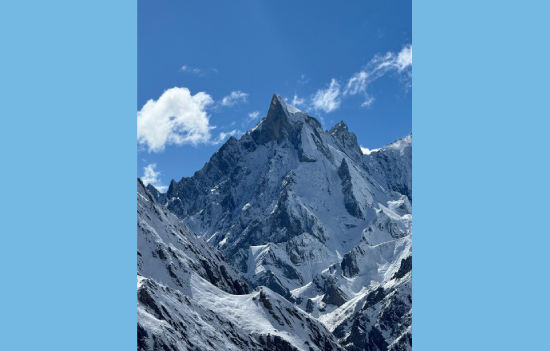 Nag Parvat.
Nag Parvat.
Om Parvat and the Sheshnag Parvat. - by 12 noon
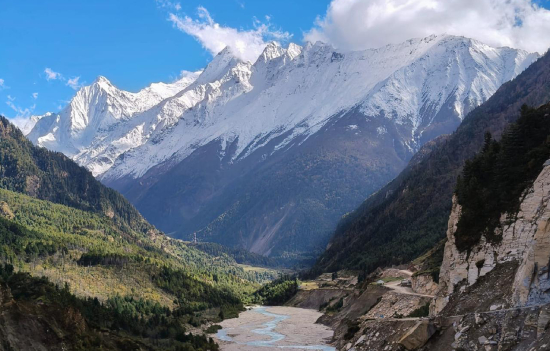 View enroute.
View enroute.
As our driver played the bhajan “Bhole tera
naam japun,” something shifted inside me — tears flowed freely. When the clouds parted, the sight that met us was otherworldly: the perfect “ॐ” etched in snow on the face of the mountain.
The air was electric with grace. Even Sheshnag Parvat, briefly hidden, revealed himself. We stood there in awe — full, speechless, grateful. That evening, as we returned, hope quietly replaced exhaustion.
Adi Kailash – The Moment of Kripa
“Sometimes faith walks ahead of reason-and the mountains part in response.”
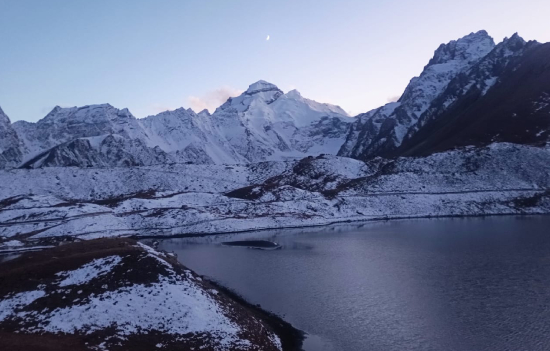 Adi Kailash with Gauri Kund. Pic by A Tiwari.
Adi Kailash with Gauri Kund. Pic by A Tiwari.
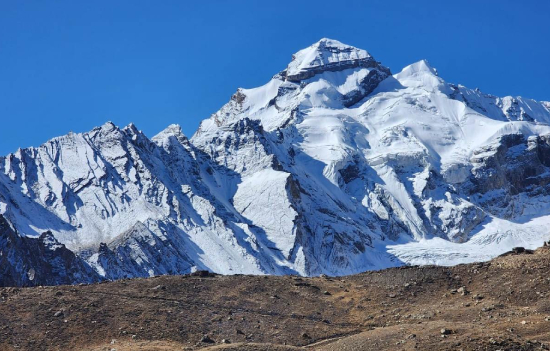 Clear view of Adi Kailash.
Clear view of Adi Kailash.
The following morning, the sky was cobalt blue, the air crisp. As we neared Kuti village, the road was blanketed with snow. For a while, we waited, unsure if we could proceed. Then, as if on cue, permission came — and we continued toward Jolingkong base camp from Gunji/Nabi village.
And
there it was - Adi Kailash, majestic and still.
A
dark serpent-like band circled its snowy slopes, uncannily like Mount Kailash.
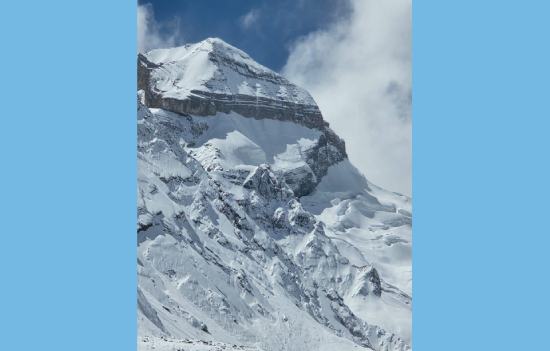 Reminded me of Kailash.
Reminded me of Kailash.
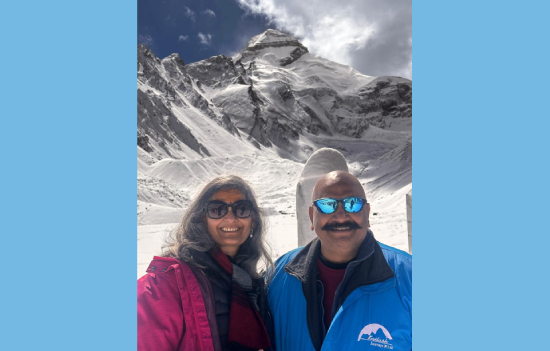 Me with Fellow Yatri Sanjeev.
Me with Fellow Yatri Sanjeev.
We walked a kilometer through thick snow to a small temple. I had been fasting for over 24 hours yet felt no hunger, no fatigue — only immense gratitude. When the priest emerged and vigorously applied chandan and turmeric to my forehead, my heart overflowed. Above us, the golden trishul glinted in sunlight, the Adi Kailash radiant behind it.
It felt as if time, space, and the Self had dissolved into silence. Shiva’s presence was everywhere.
Both
ways, we enjoyed homely Lunch at Yashoda
Bhojanalay in village Budhi.
Homeward Bound
The first stopover for the night post
Adikailash was at Kailash Manasarovar hotel at Dharchula. Here we experienced
the earthquake next morning, and we were given Yatra completion certificates.
The journey back was long — snow, slush, winding roads. On way to Tanakpur, we had Chai at Dhami Bhojnalay. From there we got
a clear view of Panchachuli. The view of Panchachuli peaks — the five chulhas lit by the Pandavas — framed the moment perfectly.
We
had divine Paneer parathas at All Weather Sweets that we visited after darshan
at Gurna Mata Mandir. My stomach had settled as if nothing had happened.
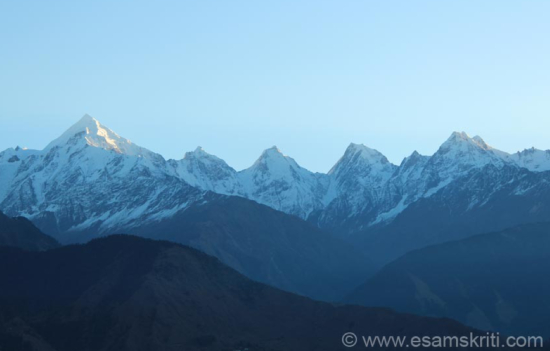 View of Panchachuli peaks from Munsiyari.
View of Panchachuli peaks from Munsiyari.
That
night at Tanakpur, with hot showers and cozy rooms, felt like returning to the
world. Shireen led a short pranayama session before dinner, and I slept deeply,
unaware that a mild earthquake had trembled through the early hours!
Reflections – Lessons from the Mountain
“Surrender is the surest path — the mountain only reveals itself to those who cease striving.”
Rain.
Snow. Landslides. Falling boulders. A car that refused to start.
Freezing temperatures from 3 to -7°C. And, finally — an earthquake.
Through
it all, not one of us complained. Not one was disappointed. We had surrendered,
completely.
When surrender is total, Shiva appears.
On
my flight back from Pantnagar, I met an elderly lady whose group had extended
their stay by three days but had not got darshan of Adi Kailash. She was astonished
when I told her we had been blessed with it on the 9th. She was
there a few days before that.
That
moment reaffirmed what I already knew-darshan happens only when the BULAVA
comes.
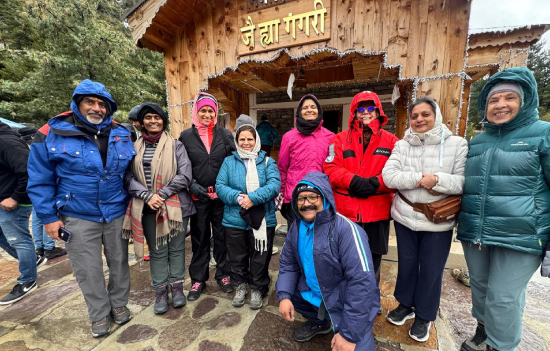 Our Group Energy brings us together. Memories for lifetimes.
Our Group Energy brings us together. Memories for lifetimes.
Shiva’s whisper lingers still: “Come to Me, and you will be forever fulfilled.”
Sat-Chit-Ananda-being,
consciousness, bliss is found within. And love-for the Lord, for all beings-is
the eternal flow we carry home.
Jai
Bhole! Jai Bhole!
Ever since the road made to Gunji, more devotees going for Yatra. Earlier road was only up to Narayan Ashram. Thereafter, had to trek to Om Parvat. It was the earlier Kailash Mansrovar Route organised by the Government of India. Locals started Home Stays means income avenues from yatris.
If you get BSF/Army approval then view Mount Kailash during trip -
Editor.
A
few years before a friend was lucky to get permission. One drives on the Om
Parvat route to reach parking lot. Then steep trek some 200 metres to Lipulekh
Pass. If lucky will get Darshan. Kailash is app 60 kms from Lipulekh Pass. To see video of drive from Gunji for Kailash Darshan 25 minutes / Video 1.3 minutes
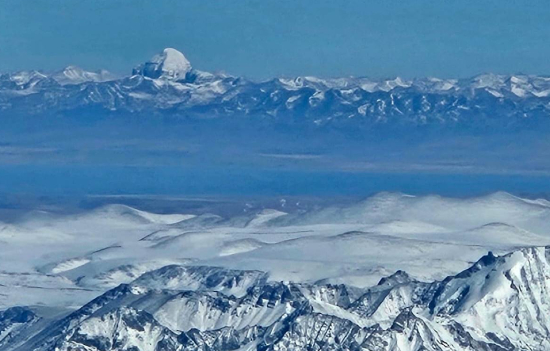 Long distance view of Mount Kailash by Ashish T.
Long distance view of Mount Kailash by Ashish T.
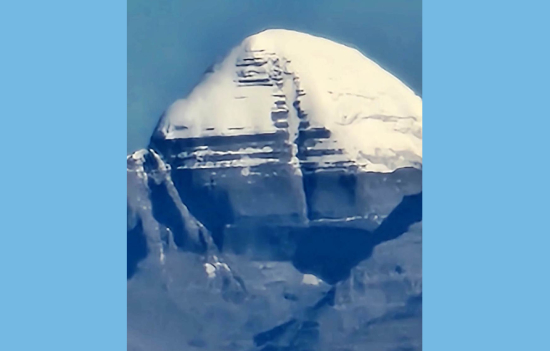 Close up of Mount
Kailash from Lipulek Pass. Pic by Ashish T.
Close up of Mount
Kailash from Lipulek Pass. Pic by Ashish T.
General information
Adi
Kailash is about 15 kms from the village Kuti (name comes from Kunti, mother of
the Pandavas). It is situated in the Vyans Valley. Parvati
Tal, a sacred lake near Adi Kailash. Adi Kailash is one of the five
sacred mountain peaks called Panch Kailash. Close by is Jolingkong Lake. Gunji
village is a small scenic village enroute to Adi Kailash. Kalapani is a Shiv
Temple near Kali river. Useful Village Gunji is
the base for visits for Adi Kailash and Om Pravat.
Also see albums
1.
Golu Devata Mandir
and Kasar Devi Mandir Almora
2.
Jageshwar Mandir
3.
Pithoragarh
4. Dharchula
5.
Narayan Ashram
Videos
Adi Kailash and Om Parvat Yatra 25 minutes and 11 minutes
Good video of Adi Kailash by Kanchan
Naithani 39 minutes. This link gives the program day
wise in an easy to understand format. A good guide
Another Bikers Video 16 minutes of Drive to Gunji.
Albums of Places we hope to visit soon
1.
Mahavatar Babaji
Cave
2.
BINSAR
3.
Dunagiri and
Pandukholi
Details
of Yatra organised by Kumaon Mandal Vikas Nigam. The day-wise schedule is –
1: Kathgodam to Pithoragarh via Jageshwar (196 km – 9 to 10 hours)
2: Pithoragarh to Dharchula (96 km – 4 to 5 hours)
3: Dharchula to Gunji (71 km – 5 to 6 hours)
4: Gunji to Nabidhang and back (44 km - 6 to 7 hours)
5: Gunji to Adi Kailash and back to Budi (86 km - 6 to 7 hours)
6: Budi to Chaukori (159 km – 5 to 6 hours)
7: Chaukori to Almora (165 km – 5 to 16 hours)
8: Almorato Kathgodam (82 km – 3 to 4 hours)
Chaukori is famous for its sunrise and sunset views.